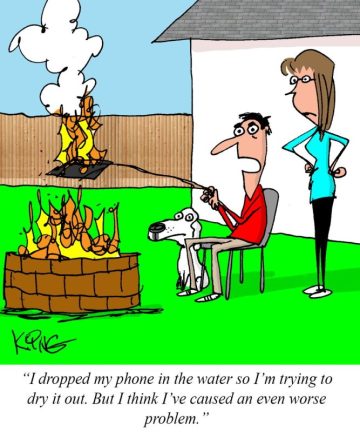Interesting Things to Know
Spring revelry: An ancient and riotous tradition
Soon it will be that time of year that delights students and worries parents. Spring break is upon us.
Despite newer destinations like Cancun beginning to rival Florida’s dominance, Florida will see hundreds of thousands of revelers.
Since Connie Francis sang “Where the Boys Are” in the 1960 movie, things have changed. Breakers today have little more money and are more likely to be younger. Even high schoolers are joining the trek south.
Something about spring urges young people to get out, relax, and rejuvenate. It has been true since Socrates proposed a rite to welcome spring and allow young people to vent their energies. At the time, local Greeks complained that the hordes of celebrants had poor morals and caused hardship to the residents of seaside towns.
In the Middle Ages, armed bands of monks stopped the spring revelry. But in spite of many objectors, spring break went on through more modern times.
During WWI, American soldiers in France watched in wonder as Europeans temporarily halted spring offensives to party. From 1929 to 1959, America was too busy with the Great Depression, World War II, and rebuilding. In the 1960s, however, spring break was back and more riotous than ever.
By the 1980s, the ritual had evolved and grown somewhat, and record numbers of students broke their parents’ pocketbooks by going south.
There is some good news. Since the 1990s, overindulgence has eased up, and corporate sponsors are helping with entertainment that includes concerts, shows, and giveaways.
Interesting Things to Know
The Mystical Origins of “Abracadabra”: A Journey Through Time and Magic
Interesting Things to Know
The 1975 “No S” Roosevelt Dime: A Hidden Treasure Worth Half a Million Dollars
Interesting Things to Know
The Return of Communal Tables: A Revival of Tradition in Modern Dining
The dining scene embraces an old tradition with a modern twist as communal tables make a comeback in restaurants nationwide. From the bustling streets of New York, Chicago, and Boston to smaller cities, these large tables that seat multiple parties are becoming increasingly popular.
Historically, communal tables were the norm in European inns and dining halls until the 19th century, when private tables began to emerge, first in Paris. Despite this shift in the West, communal seating continued to thrive in places like Japan and other parts of Asia. Today, as society grapples with the digital age’s isolating effects, these tables are reappearing in restaurants as spaces that foster social interaction and community building.
Sitting anywhere from 8 to 16 diners, communal tables are a nod to bygone eras and a smart business strategy for restaurateurs. They maximize seating capacity and provide a flexible option for accommodating larger groups, which might require complex arrangements of smaller tables.
For guests, the experience of dining at a communal table can be a leap out of their comfort zones. Yet, many find it a refreshing opportunity to engage with new people, turning what could be a simple meal into a memorable social event. The concept encourages diners to connect in an increasingly rare way in our screen-dominated lives, offering a chance to meet friends you never knew you had.
Whether you’re dining alone, with friends, or looking to make new ones, communal tables offer a unique culinary and social experience that combines the charm of historical dining practices with the dynamic needs of modern life. So next time you’re out, consider choosing the communal table—it might transform your dining experience.
Interesting Things to Know
Celebrity May Birthdays!
Do you share a birthday with a celebrity?

Roma Downey, 60, actress (Touched by an Angel), Derry, Northern Ireland, 1964. Photo by Salvation Army USA West – JG1_7228, CC BY 2.0, https://commons.wikimedia.org/w/index.php?curid=47458719
1 – Judy Collins, 85, singer, Seattle, WA, 1939.
2 – Jenna Von Oy, 47, actress (Blossom), Newtown, CT, 1977.
3 – Engelbert Humperdinck, 88, singer, born Gerry Dorsey, Madras, India, 1936.
4 – David Guterson, 68, author (Snow Falling on Cedars), Seattle, WA, 1956.
5 – Henry Cavill, 41, actor (The Tudors), Jersey, Channel Islands, U.K., 1983.
6 – Roma Downey, 60, actress (Touched by an Angel), Derry, Northern Ireland, 1964.
7 – Peter Carey, 81, author (Oscar and Lucinda), born Bacchus Marsh, Australia, 1943.
8 – Stephen Amell, 43, actor (Arrow), Toronto, ON, Canada, 1981.
9 – Billy Joel, 75, singer, composer, born Hicksville, NY, 1949.
10 – Jason Brooks, 58, actor (Days of Our Lives), Colorado Springs, CO, 1966.
11 – Matt Leinart, 41, sports analyst, former football player, 2004 Heisman Trophy winner, Santa Ana, CA, 1983.
12 – Bruce Boxleitner, 73, actor (Babylon 5), Elgin, IL, 1951.
13 – Julianne Phillips, 62, actress (Allie & Me), Lake Oswego, OR, 1962.
14 – Mark Zuckerberg, 40, founder of Facebook, White Plains, NY, 1984.
15 – Chazz Palminteri, 73, actor (A Bronx Tale), playwright, the Bronx, NY, 1952.
16 – Pierce Brosnan, 71, actor (Remington Steele), County Meath, Ireland, 1953.
17 – Sendhil Ramamurthy, 50, actor (Heroes), Chicago, IL, 1974.
18 – James Stephens, 73, actor (The Paper Chase), Mount Kisco, NY, 1951.
19 – Lainey Wilson, 32, singer, Basken, LA., 1992,
20 – Timothy Olyphant, 56, actor (Justified), Honolulu, HI, 1968.
21 – Sarah Ramos, 33, actress (Parenthood), Los Angeles, CA, 1991.
22 – Naomi Campbell, 54, model, actress (Empire), London, U.K., 1970.
23 – Jewel, 47, singer (Pieces of You), born Jewel Kilcher, Payson, UT, 1974.
24 – Bob Dylan, 83, Rock and Roll and Songwriters halls of fame composer, singer, born Robert Zimmerman, Duluth, MN, 1941.
25 – Cillian Murphy, 48, actor (Oppenheimer), Douglas, Ireland, 1976.
26 – Lenny Kravitz, 60, actor (The Hunger Games), singer, musician, songwriter, New York, NY, 1964.
27 – Richard Schiff, 69, actor (The West Wing), Bethesda, MD, 1955.
28 – Gladys Knight, 80, singer, Atlanta, GA, 1944.
29 – Carmelo Anthony, 40, basketball player, New York, NY, 1984.
30 – CeeLo Green, 49, singer, rapper, record producer, born Thomas DeCarlo Callaway, Atlanta, GA, 1975.
31 – Chris Elliott, 64, writer, comedian, New York, NY, 1960.
Interesting Things to Know
Crafting a Joyful Retirement Beyond the Finances
The financial aspect often takes center stage when the conversation turns to retirement. However, a critical component of retirement planning goes beyond the numbers: social connectivity. As careers wind down and the daily interactions of the workplace fade, maintaining relationships becomes a task that requires intention and effort. The importance of this aspect can’t be overstated, as highlighted by an extensive 85-year study by Harvard, which revealed that social fitness is paramount to achieving a happy retirement.
The study’s findings underscore that while retirees may not miss their former jobs, they deeply miss the social connections formed in the workplace. This suggests that a fulfilling retirement involves much more than pursuing hobbies or leisure activities; it hinges on the richness of our personal connections.
Psychologists Robert Waldinger, PhD, and Marc Schulz, PhD, emphasize the importance of nurturing these connections even before stepping into retirement. They encourage reflecting on the relationships that bring joy and fulfillment and taking steps to strengthen those bonds. Appreciating and valuing the people in our lives today lays the groundwork for a socially rich retirement tomorrow.
For those already in retirement and feeling a gap in their social lives, Waldinger and Schulz offer guiding questions to help identify what connections are missing and how to foster them. Whether reaching out to someone you’d like to know better, seeking out individuals with different perspectives, or even embarking on activities you never considered before retirement, the goal is to create a diverse and enriching social landscape.
Stanley Bing, a Forbes humorist, humorously suggested establishing a “daily grind” in retirement to appreciate the joy of vacations and advised maintaining a healthy distance from becoming too entangled in family members’ daily lives. His take, while humorous, underscores the idea that retirement should be a time of personal growth and exploration.
A happy retirement is multifaceted, encompassing financial stability, personal fulfillment, and, importantly, active engagement in a social network. Cultivating and maintaining these connections enriches our lives and ensures our retirement years are vibrant and joyful.
Interesting Things to Know
The Heist of the Century: How an Aging Mobster’s Quest for Judy Garland’s Ruby Slippers Went Awry
In a tale that seems pulled straight from a Hollywood script, Terry Jon Martin’s life took a turn towards the criminal when he set his sights on one of the most iconic pieces of film memorabilia: the ruby slippers worn by Judy Garland in The Wizard of Oz. Unbeknownst to Martin, who grew up far removed from the movie’s cultural impact, the slippers’ true value lay not in precious stones but in their irreplaceable cinematic history.
After a tumultuous life of crime and multiple prison sentences, the last of which ended in 1996, Martin sought a fresh start in Grand Rapids, Minnesota. This quiet town, coincidentally the birthplace of Judy Garland, hosts a museum dedicated to the actress, within which a pair of the famed ruby slippers were displayed. In 2005, driven by misinformation and the lure of what he believed to be a final, lucrative heist, Martin embarked on a daring smash-and-grab to claim the slippers, insured for a rumored million dollars.
However, the dream of a final big score quickly dissolved. Within days of the successful theft, Martin discovered the disappointing truth—the slippers’ “gems” were mere fakes, rendering the shoes nearly worthless on the black market. Discarding the slippers, he returned to his ordinary life, leaving the shoes hidden from the world.
The slippers’ disappearance remained a mystery until 2018 when they were recovered in an FBI sting operation. This closed a chapter on one of the most intriguing heists in film memorabilia history. Martin, now 76 and facing the end of his life in hospice care, confessed to his role in the theft in federal court last year. Due to his health and condition, he was spared prison and sentenced instead to supervised release for his remaining days.
It remains unclear whether Martin has ever watched the film that once inspired his criminal aspirations. What is certain, however, is that the legend of the ruby slippers—and the man who dared to steal them—will continue to captivate audiences, much like the movie that started it all.








































































